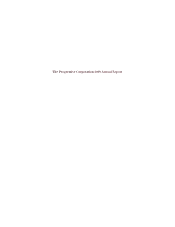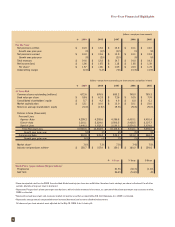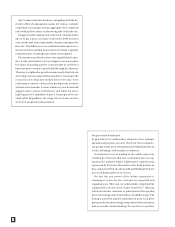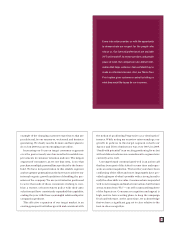Progressive 2009 Annual Report Download - page 11
Download and view the complete annual report
Please find page 11 of the 2009 Progressive annual report below. You can navigate through the pages in the report by either clicking on the pages listed below, or by using the keyword search tool below to find specific information within the annual report.
15
Clearly, the consumer demand generation objective
of a brand is essential and, in 2009, we were served well,
but for me there is an even bigger contribution to our
customer care culture that has been served by our brand-
building efforts. Employees at every level identify with
Flo, and with the positive brand characteristics she
demonstrates to customers and shoppers —even her
quirkiness. When we challenge ourselves with the ques-
tion —“Who does the customer expect to answer the
phone or settle a claim?,” the immediate answer is clear
and, while common sense suggests it will not be Flo, the
expectations are unchanged.
Our customer-focused agenda has been a source of
some pride for us over the past several years but the
model of brand ambassadorship exhibited by Flo, and
accepted by all employees with similar enthusiasm,
ensures the critical congruence of brand messaging
and brand execution.
Late in the second quarter, and continuing through the
second half of the year, we saw the emergence of stronger
new application growth in our Agency business. This was a
very positive sign we had not seen for some time.While net
growth in Agency auto policies in force for the year was
slight, it reversed a multi-year declining trend. We always
have theories on the pricing adequacy of our competitors
and were not surprised when some increased rates in
amounts that outstripped our estimates of loss-cost trends.
Relative positioning on price is an important consideration
in the Agency business and being comfortable with our rate
level when others need additional rate is a position we like
to be in. We have also taken additional measures to present
our rates to agents such that they can ensure the consumer
is offered the best options we can make available.
We consider our access to consumers via independent
agents and directly, now primarily via the Internet, to be a
significant strategic advantage over many in our space.
The strategies are largely the same in each channel and,
although our advertising is designed to incent consumers
to shop with us directly, our recognition and support of
consumer choice is unwavering. Agents have consis
-
tently expressed support for, and excitement about, our
brand-building efforts and the positive reflection it has
on their business.
Our Agency business remains the larger portion of our
Personal Lines business and the dominant part of our
Commercial Auto production. The Direct business, which
perhaps reflects consumers’ changing buying habits, is
now substantial. Against the relatively flat growth in cus-
tomers in Agency, Direct grew 13% for the year and is now
about 43% of our personal auto policies in force. Both busi-
nesses produced combined ratios between 93 and 94 for
personal auto for the year. Of some note is that the annual
trend in average written premium is relatively flat
for the
Agency business,
and still quite negative for Direct, at-4%,
tempering Direct’s top line growth to 11%.
Aggregate measures of combined ratio ultimately are
most important, and our goal of an aggregate companywide
96 in any calendar year is unchanged. With room for some
debate, the Agency auto business, along with the special
lines and Commercial Auto businesses, are best thought of
as variable cost acquisition businesses for which calendar-
year combined ratio is an accurate assessment.
The key to controlling the Direct business is having a
very clear understanding of target margins during the life
of a policy, based on an accepted recognition period for
acquisition costs, and an ability to predict policy life ex-
pectancy by consumer segment with some reliability. With
a substantial base of renewal business in the Direct book,
our calendar combined ratios have been consistently
below 96. However, under certain high growth new busi-
ness scenarios, we would be happy to see the reported
monthly and calendar-year combined ratios go above 96
for our Direct business, as long as our new and renewal
business consistently meets predefined targets that ensure
a lifetime result at or below 96.
Surpassing aggregate written premium of $14 billion
in 2009 was welcomed, but it’s not the first time we have
We respect the environment and are mindful of the
impact of our actions, as evidenced by our offer to
fund the planting of a tree in a U.S. National Forest
on behalf of each of the first one million customers
who chose to go paperless by receiving their policy
documents online.
























